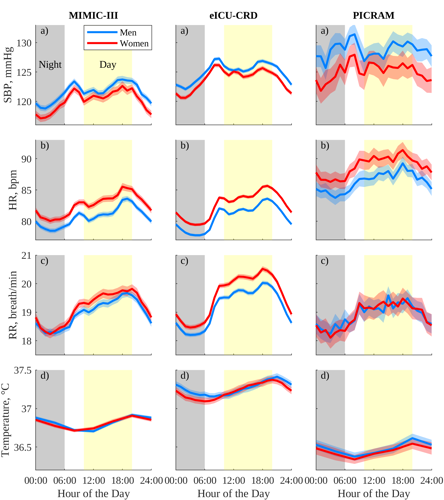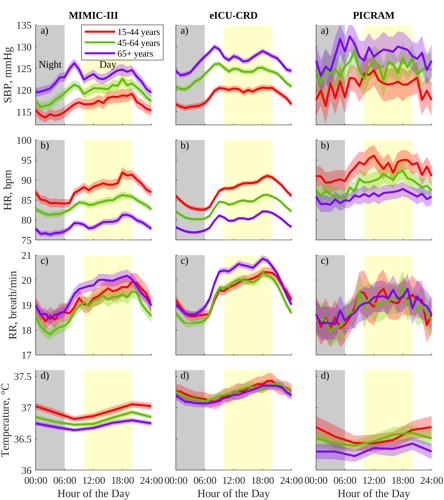Resources: MIMIC-III and eICU-CRD

Resources: MIMIC-III and eICU-CRD
MIMIC-III and eICU-CRD vital-sign profile toolbox
The toolbox available here was developed while writing "Vital-sign circadian rhythms in patients prior to discharge from an ICU: a retrospective observational analysis of routinely recorded physiological data". The abstract for this paper, along with example figures, is presented below. The toolbox contains a readme file with detailed instructions on how to set up and run the code on the MIMIC-III and eICU-CRD databases.
Abstract:
Background: Circadian deregulation in patients treated in an intensive care unit (ICU) is commonplace and is associated with complications such as immune system disruption and delirium. The presence and nature of circadian rhythms in the vital signs recorded in the ICU are not well documented, nor is their generalisability across different ICU populations. This paper investigates the presence of circadian rhythms in the 24 h prior to discharge from an ICU of patients who subsequently recovered. We hypothesise that vital-sign circadian rhythms will be observable in this cohort of patients, that these circadian rhythms will resemble known behaviour in healthy individuals, and that these circadian rhythms will be generalisable across different populations of ICU patients.
Methods: Circadian rhythms are investigated across several commonly measured vital signs: systolic blood pressure, heart rate, respiratory rate, and temperature. The data employed in this paper are from patients in the MIMIC-III (2001–2012), eICU-CRD (2014–2015), and PICRAM (2009–2015) databases, spanning 198,205 patients across 211 hospitals in the USA and the UK. Evaluation of circadian rhythms encompasses a comparison between the observed rhythm profiles and peak-nadir excursions with those found in the literature, as well as the assessment of the correlation in rhythm profiles between databases.
Results: Circadian patterns in all four vital signs were found to conform to those reported for non-ICU cohorts. Additionally, all vital-sign circadian profiles were correlated between databases at the p = 0.05 level. The peak-nadir excursion in the observed rhythms was suppressed by a factor of 2–5 relative to results found in the literature for cohorts of young, healthy individuals.
Conclusions: Across three different ICU datasets, systolic blood pressure, heart rate, respiratory rate, and temperature showed circadian variation in the 24 h prior to discharge from an ICU. However, the amplitude of these variations was markedly reduced in comparison to cohorts of young, healthy adults. The observed circadian variation correlated strongly between databases, suggesting there is a generalisable state of circadian behaviour in ICU patients during the 24 h prior to discharge from an ICU. This result has potential uses in monitoring patient recovery and early detection of complications such as delirium.
Example figures:



ICU vital-sign profile toolbox
Datasets:
The datasets used by the toolbox are available in the following repositories: MIMIC-III and eICU-CRD
When using this code, please cite the following manuscript:
Shaun Davidson, Mauricio Villarroel, Mirae Harford, Eoin Finnegan, João Jorge, John Duncan Young, Peter J Watkinson and Lionel Tarassenko. "Vital-sign circadian rhythms in patients prior to discharge from an ICU: a retrospective observational analysis of routinely recorded physiological data." Critical Care, 24:181, 2020." Critical Care, 24:181, 2020 [Download PDF] [Published version]
Please email: shaun.davidson@eng.ox.ac.uk for any troubleshooting or bug reports.
Vital-sign circadian rhythms in patients prior to discharge from an ICU: a retrospective observational analysis of routinely recorded physiological data
Background: Circadian deregulation in patients treated in an intensive care unit (ICU) is commonplace and is associated with complications such as immune system disruption and delirium. The presence and nature of circadian rhythms in the vital signs recorded in the ICU are not well documented, nor is their generalisability across different ICU populations. This paper investigates the presence of circadian rhythms in the 24 h prior to discharge from an ICU of patients who subsequently recovered. We hypothesise that vital-sign circadian rhythms will be observable in this cohort of patients, that these circadian rhythms will resemble known behaviour in healthy individuals, and that these circadian rhythms will be generalisable across different populations of ICU patients.
Methods: Circadian rhythms are investigated across several commonly measured vital signs: systolic blood pressure, heart rate, respiratory rate, and temperature. The data employed in this paper are from patients in the MIMIC-III (2001–2012), eICU-CRD (2014–2015), and PICRAM (2009–2015) databases, spanning 198,205 patients across 211 hospitals in the USA and the UK. Evaluation of circadian rhythms encompasses a comparison between the observed rhythm profiles and peak-nadir excursions with those found in the literature, as well as the assessment of the correlation in rhythm profiles between databases.
Results: Circadian patterns in all four vital signs were found to conform to those reported for non-ICU cohorts. Additionally, all vital-sign circadian profiles were correlated between databases at the p = 0.05 level. The peak-nadir excursion in the observed rhythms was suppressed by a factor of 2–5 relative to results found in the literature for cohorts of young, healthy individuals.
Conclusions: Across three different ICU datasets, systolic blood pressure, heart rate, respiratory rate, and temperature showed circadian variation in the 24 h prior to discharge from an ICU. However, the amplitude of these variations was markedly reduced in comparison to cohorts of young, healthy adults. The observed circadian variation correlated strongly between databases, suggesting there is a generalisable state of circadian behaviour in ICU patients during the 24 h prior to discharge from an ICU. This result has potential uses in monitoring patient recovery and early detection of complications such as delirium.
@article{davidson2020vital,
title={Vital-sign circadian rhythms in patients prior to discharge from an ICU: a retrospective observational analysis of routinely recorded physiological data},
author={Davidson, Shaun and Villarroel, Mauricio and Harford, Mirae and Finnegan, Eoin and Jorge, Joao and Young, Duncan and Watkinson, Peter and Tarassenko, Lionel},
journal={Critical Care},
volume={24},
number={1},
pages={1--13},
year={2020},
publisher={BioMed Central}
}
